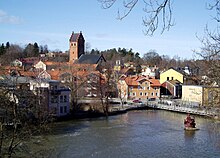Torshälla
| Torshälla | ||||
|
||||
| State : | Sweden | |||
| Province (län): | Södermanland County | |||
| Historical Province (landskap): | Södermanland | |||
| Municipality : | Eskilstuna | |||
| Coordinates : | 59 ° 25 ′ N , 16 ° 28 ′ E | |||
| SCB code : | 0880 | |||
| Status: | Crime scene | |||
| Residents : | 8928 (December 31, 2015) | |||
| Area : | 9.18 km² | |||
| Population density : | 973 inhabitants / km² | |||
| List of perpetrators in Södermanland County | ||||

Torshälla [ 'tɔʂhɛla ], German obsolete Torsil , is a locality ( tatort ) , titular town and since 1971 part of the municipality Eskilstuna in the Swedish province of Södermanland County and the historical province of Södermanland . It is located in the municipality of Eskilstuna , seven kilometers north of the town of Eskilstuna . Torshälla is an originally pagan settlement, received city rights in 1317 and was an independent municipality until the municipal reform in 1971. Torshälla is known nationwide mainly for the steel industry and the historic town center.
history
The place emerged as a pagan settlement before the 12th century, which can already be seen from the fact that Torshälla means something like "place for sacrifice to the god Thor ". The oldest parts of today's local church date from the 12th century , the time of the Christianization of Sweden.
Torshälla is located on the first rapids upstream of the mouth of the Eskilstunaån River ( called Torshällaån in Torshälla ) into Lake Mälaren and has long been a strategically important place for trade between Lakes Mälaren and Hjälmaren . There was a large merchant fleet here, which was important for the supply of the other cities in the valley of the Mälaren. Until 1660 the place, which received city rights from King Birger I on February 24, 1317 , was owned by the (Eskils-) Tuna trading center . After a major fire in 1798 that devastated the main part of the old town and the construction of a canal that bypassed the old port, Torshälla was overtaken by Eskilstuna.
In 1829 the Nyby Bruk ironworks was founded on the site of the Nyby manor on the western outskirts of Torshalla by the silversmith and industrialist Adolf Zethelius. The Nyby Bruk industrial estate was built next to the ironworks. In 1895 the Norra Södermanlands Järnväg railway line was built by Nyby Bruk.
Through the municipal reform in 1971 Torshälla became part (Kommundel) of the Eskilstuna municipality , with its own committee in the municipal council. In the 1970s and 1980s, the new situation led to almost all trading houses in Eskilstuna being established. The re-establishment of an independent municipality Torshälla was clearly rejected in a referendum in 2006.
Economy and Infrastructure
The city's largest company and employer is Outokumpu , which produces cold-formed stainless steel products at Nyby Bruk. Many residents work in Eskilstuna or Stockholm , and the trend for decades has been that Torshälla is increasingly becoming a dormitory town.
traffic
The railway line to Eskilstuna , built in the 1890s as part of the Norra Södermanlands Järnväg ( Södertälje - Mälarbaden ), has only been used for goods transport from the Nyby Bruk steelworks since 1933. The route north from Torshälla to Mälarbaden has since been closed and dismantled.
The city center is 4 km north of the E20 trunk road .
Culture and sights
- Bergströmska gården, ( Bergström'scher Hof ), local history museum and civic yard from the 18th century.
- Ebelingmuseet , an art museum with a permanent exhibition of works by the Swedish-American artist and ceramist Allan Ebeling.
- Nyby Bruk, an early industrial industrial settlement from the 19th century. The Nyby manor with park belongs to the settlement.
- Torshälla Church. The ceiling paintings were probably painted in the 15th century by the German-Swedish church painter Albertus Pictor , and show the oldest medieval illustration of glasses in Sweden.
- Torshälla Town Hall, built in 1833. The town hall clock was removed from Strängnäs Cathedral in 1580 and installed in Torshälla Church.
Personalities
- Kjell Bergqvist (born 1953), actor.
- Åsa Brandt , glass artist .
- Allan Ebeling (1897–1975), Swedish-American artist and ceramist.
- Ulf Kristersson (* 1963 in Lund ), politician and party leader of the Moderata Samlingspartiet, grew up in Torshälla.
- Anni-Frid Lyngstad Princess Reuss von Plauen (* 1945), member of the Swedish pop group ABBA , grew up in Torshälla.
- Markus Mustonen , member of the rock band Kent .
- Anna Nordqvist , golfer for Torshälla GK.
- Yvonne Ryding , Miss Universe 1984.
- Sami Sirviö , member of the rock band Kent .
- Sulo Vaattovaara (* 1962), soccer player and coach.
Web links
Individual evidence
- ↑ a b Statistiska centralbyrån : Land area per Tatort, folkmängd and invånare per square kilometer. Vart femte år 1960 - 2015 (database query)
- ↑ Torshälla . In: Vetenskapsakademi (ed.): Sveriges statskalender för år 1925 . Almqvist & Wiksell boktryckeri AB, 1925, ZDB -ID 205099-7 , p. 1081 (Swedish, runeberg.org ).
- ↑ Alla tiders historia om Nyby Bruk, 1996
- ↑ NrSlJ, Norra Södermanlands Järnväg




